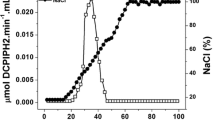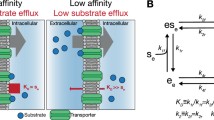Summary
The yeastRhodotorula gracilis accumulated glucuronate by an H+/symport. The transport was electroneutral, driven by the chemical gradient of protons Δ pH. The observed stoichiometry amounted to 1 proton per molecule glucuronate. At pH 4, the half-saturation constantK T was at its lowest value (K T =8mm), whereas the maximal velocityV T reached a maximum (V T =15 nmol/min×mg dry wt). Monosaccharides competitively inhibited the uptake of glucuronate and vice versa. Hence, the two substrates share the same transport system. The steady-state accumulation of glucuronate reflected the course of the pH gradient. It is concluded that glucuronate is transported as an anionic substrate by the protonated carrier, the driving force being the chemical gradient of the H+ (ΔpH). The ternary carrier/H+/glc-COOO-complex is electroneutral and independent of the membrane potential. Simultaneous uptake of organic acids (acetic or propionic acid) which is also energized by the pH gradient led to a noncompetitive inhibition of glucuronate transport. Thus, manipulation of the driving force, ΔpH, reducedV T without affectingK T . Kinetic and energetic arguments are presented which stronly suggest that only the protonated carrier is catalytically active inR. gracilis.
Similar content being viewed by others
References
Alcorn, M.E., Griffin, C.C. 1978. A kinetic analysis ofd-xylose transport inRhodotorula glutinis.Biochim. Biophys. Acta 510:361–371
Brewer, J.M., Pesce, A.J., Ashworth, R.B. 1974. Experimental Techniques in Biochemistry, p. 299. Prentice Hall, Englewood Cliffs, N.J.
Eddy, A.A. 1978. Proton-dependent solute transport in microorganisms.Curr. Top. Membr. Transp. 10:279–360
Eddy, A.A. 1982. Mechanisms of solute transport in selected eukaryotic microorganisms.Adv. Microb. Physiol. 23:1–78
Harold, F.M. 1977. Membranes and energy transduction in bacteria.Curr. Top. Bioenerg. 6:83–149
Hauer, R., Höfer, M. 1978. Evidence for interactions between the energy-dependent transport of sugars and the membrane potential in the yeastRhodotorula gracilis (Rhodosporidium toruloides).J. Membrane Biol. 43:335–349
Hauer, R., Höfer, M. 1982. Variable H+/substrate stoichiometries inRhodotorula gracilis are caused by a pH-dependent protonation of the carrierts).Biochem. J. 208:459–464
Heinz, E., Geck, P. 1978. The electrical potential difference as a driving force in Na+-linked cotransport of organic solutes.In: Membrane Transport Processes. J.F. Hoffman, editor, Vol. 1, pp. 13–30. Raven, New York
Heller, K.B., Höfer, M. 1975. Temperature dependence of the energy-linked monosaccharide transport across the cell membrane ofRhodotorula gracilis.J. Membrane Biol. 21:261–271
Höfer, M., Becker, J.-U. 1972. Regulations möglichkeiten des Stoffwechsels von Monosacchariden und Carbonsäuren beiRhodotorula gracilis.Zentralbl. Bakteriol. Parasitenkd. Infektionskr. Hyg. Abt. 1: Orig. Reihe A 220:374–379
Höfer, M., Huh, H., Künemund, A. 1983. Membrane potential and cation permeability. A study with a nystatin-resistant mutant ofRhodotorula gracilis (Rhodosporidium toruloides).Biochim. Biophys. Acta 735:211–214
Höfer, M., Kotyk, A. 1968. Tight coupling of monosaccharide transport and metabolism inRhodotorula gracilis.Folia Microbiol. (Prague) 13:197–204
Höfer, M., Misra, P.C. 1978. Evidence for a H+-sugar symport in the yeastRhodotorula gracilis (glutinis).Biochem. J. 172:15–22
Höfer, M., Thiele, O.W., Huh, H., Hunneman, D.H., Mracek, M. 1982. A nystatin-resistant mutant ofRhodotorula gracilis. Transport properties and sterol content.Arch. Microbiol. 132:313–316
Kaczorowski, G.J., Kaback, H.R. 1979. Mechanism of lactose translocation in membrane vesicles fromEscherichia coli. 1. Effect of pH on efflux, exchange, and counterflow.Biochemistry 18:3691–3697
Kaczorowski, G.J., Robertson, D.E., Kaback, R. 1979. Mechanism of lactose translocation in membrane vesicles fromEscherichia coli. 2. Effect of imposed Δψ, ΔpH, and ΔµH+.Biochemistry 18:3697–3704
Komor, E., Schwab, W.G.M., Tanner, W. 1979. The effect of intracellular pH on the rate of hexose uptake inChlorella.Biochim. Biophys. Acta 555:524–530
Komor, E., Tanner, W. 1974. The hexose-proton cotransport system ofChlorella. pH-dependent change inK m values and translocation constants of the uptake system.J. Gen. Physiol. 64:568–581
Komor, E., Tanner, W. 1975. Simulation of a high- and low-affinity sugar-uptake system inChlorella by a pH-dependent change in theK m of the uptake system.Planta 123:195–198
Lineweaver, H., Burk, D. 1934. The determination of enzyme dissociation constants.J. Am. Chem. Soc. 56:658–666
Misra, P.C., Höfer, M. 1975. An energy-linked proton extrusion across the cell membrane ofRhodotorula gracilis.FEBS Lett. 52:95–99
Niemietz, C. 1982. Aktiver Transport geladener Substrate über ein Protonen-Monosaccharid-Symport-System: Transport von Aminozuckern und Uronsäuren bei der HefeRhodotorula gracilis (Rhodosporidium toruloides). Ph.D. Thesis. University of Bonn, West Germany
Niemietz, C., Hauer, R., Höfer, M. 1981. Active transport of charged substrates by a proton/sugar co-transport system. Amino-sugar uptake in the yeastRhodotorula gracilis.Biochem. J. 194:433–441
Niven, D.F., Hamilton, W.A. 1974. Mechanism of energy coupling to the transport of amino acids byStaphylococcus aureus.Eur. J. Biochem. 44:517–522
Page, M.G.P., West, I.C. 1981. The kinetics of the β-galactoside-proton symport ofEscherichia coli.Biochem. J. 196:721–731
Schwab, W.G.M., Komor, E. 1978. A possible mechanistic role of the membrane potential in proton-sugar cotransport ofChlorella.FEBS Lett. 87:157–160
Thomas, E.L., Christensen, H.N. 1971. Nature of the cosubstrate action of Na+ and neutral amino acids in a transport system.J. Biol. Chem. 246:1682–1688
West, I.C. 1980. Energy coupling in secondary active transport.Biochim. Biophys. Acta 604:91–126
Wright, J.K., Overath, P. 1980. Lactose transport inEscherichia coli: Effects of transmembrane potential difference on apparent substrate affinity.Biochem. Soc. Trans. 8:279–281
Wright, J.K., Teather, R.M., Overath, P. 1979. Lactose carrier proteins of the two binding sites.In: Function and Molecular Aspects of Biomembrane Transport. E. Quagliariello, F. Palmieri, S. Papa and M. Klingenberg, editors. pp. 239–248. Elsevier/North Holland, Amsterdam
Author information
Authors and Affiliations
Rights and permissions
About this article
Cite this article
Niemietz, C., Höfer, M. Transport of an anionic substrate by the H+/monosaccharide symport inRhodotorula gracilis: Only the protonated form of the carrier is catalytically active. J. Membrain Biol. 80, 235–242 (1984). https://doi.org/10.1007/BF01868441
Received:
Revised:
Issue Date:
DOI: https://doi.org/10.1007/BF01868441




